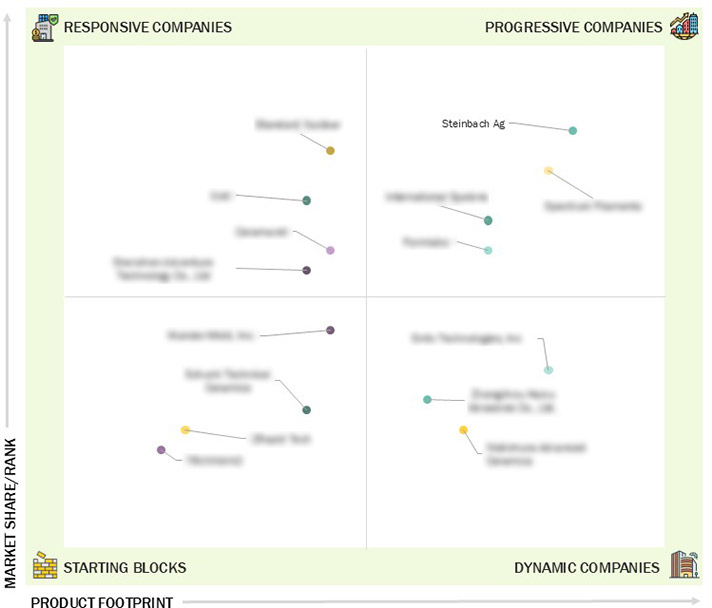Comparing 15 vendors in 3D Printing Ceramics Startups across 0 criteria.
3D printing ceramics involve using advanced techniques to create durable, heat-resistant components from non-metallic minerals. These methods enable precise fabrication for industries like aerospace, healthcare, automotive, and construction. Applications range from dental implants and medical instruments to engine parts and electronic components. Innovations in printing processes and material composition are expanding capabilities, especially in sectors requiring lightweight, thermally stable, and biocompatible materials. The technology supports complex designs and customization, making it vital for modern manufacturing and research.
Market Leadership Quadrant
1.1 Study Objectives
1.2 Market Definition
1.2.1 Inclusions and Exclusions
1.3 Market Scope
1.3.1 Market S Covered and Regional Scope
1.3.2 Years Considered
1.3.3 Currency Considered
1.3.4 Units Considered
1.4 Limitations
1.5 Stakeholders
1.6 Summary of Changes
2.1 Introduction
2.2 Market Dynamics
2.2.1 Drivers
2.2.1.1 Ongoing Research & Development
2.2.1.2 Increase in Partnerships & Collaboration Among Players in
Ecosystem
2.2.2 Restraints
2.2.2.1 High Cost Compared to Other 3D Printing Materials
2.2.2.2 Economy of Scale Not Achieved
2.2.3 Opportunities
2.2.3.1 Increase in Investments in 3D Printing Ceramics
Manufacturing
2.2.3.2 Development of Advanced Printers Compatible with Ceramics
2.2.4 Challenges
2.2.4.1 Availability of Substitutes
2.2.4.2 Capital-intensive Production and Complex Manufacturing
Process
2.3 Porter’s Five Forces Analysis
2.3.1 Threat of New Entrants
2.3.2 Threat of Substitutes
2.3.3 Bargaining Power of Suppliers
2.3.4 Bargaining Power of Buyers
2.3.5 Intensity of Competitive Rivalry
2.4 Ecosystem Analysis
2.5 Value Chain Analysis
2.6 Technology Analysis
2.6.1 Key Technologies
2.6.1.1 Stereolithography
2.6.1.2 Binder Jetting
2.6.2 Complementary Technologies
2.6.2.1 Fused Filament Fabrication (FFF)
2.7 Impact of AI/Gen AI on 3D Printing Ceramics Market
2.7.1 Top use Cases and Market Potential
2.7.2 Case Studies of AI Implementation in 3D Printing Ceramics Market
2.8 Macroeconomic Outlook
2.8.1 Introduction
2.8.2 GDP Trends and Forecast
2.8.3 Trends in Global Aerospace & Defense Industry
2.8.4 Trends in Global Healthcare Industry
2.9 Patent Analysis
2.9.1 Introduction
2.9.2 Methodology
2.9.3 Patent Types
2.9.4 Insights
2.9.5 Legal Status
2.9.6 Jurisdiction Analysis
2.9.7 Top Applicants
2.10 Key Conferences and Events, 2025–2026
2.11 Trends/Disruptions Impacting Customer Business
2.12 Investment and Funding Scenario
2.13 Impact of US Tariff on 3D Printing Ceramics Market
2.13.1 Introduction
2.13.2 Key Tariff Rates
2.13.3 Price Impact Analysis
2.13.4 Impacts on Country/region
2.13.4.1 US
2.13.4.2 Europe
2.13.4.3 Asia Pacific
2.13.5 Impact on End-use Industries
3.1 Overview
3.2 Key Player Strategies/Right to Win
3.3 Revenue Analysis, 2020–2024
3.4 Market Share Analysis, 2024
3.5 Brand/Product Comparative Analysis
3.5.1 Brand/Product Comparative Analysis
3.6 Company Evaluation Matrix: Startups/SMEs, 2024
3.6.1 Progressive Companies
3.6.2 Responsive Companies
3.6.3 Dynamic Companies
3.6.4 Starting Blocks
3.6.5 Competitive Benchmarking of Key Startups/SMEs, 2024
3.6.5.1 Detailed List of Key Startups/SMEs
3.6.5.2 Competitive Benchmarking of Key Startups/SMEs
3.7 Company Valuation and Financial Metrics of 3D Printing Ceramics Vendors
3.8 Competitive Scenario
3.8.1 Product Launches
3.8.2 Deals
3.8.3 Expansions
4.1 STEINBACH AG
4.1.1 Business overview
4.1.2 Products/Solutions/Services offered
4.1.3 Recent developments
4.2 XJET
4.2.1 Business overview
4.2.2 Products/Solutions/Services offered
4.2.3 Recent developments
4.3 ZRAPID TECH
4.3.1 Business overview
4.3.2 Products/Solutions/Services offered
4.3.3 Recent developments
4.4 TRUNNANO
4.4.1 Business overview
4.4.2 Products/Solutions/Services offered
4.4.3 Recent developments
4.5 INTERNATIONAL SYALONS
4.5.1 Business overview
4.5.2 Products/Solutions/Services offered
4.5.3 Recent developments
4.6 FORMLABS
4.6.1 Business overview
4.6.2 Products/Solutions/Services offered
4.6.3 Recent developments
4.7 SCHUNK TECHNICAL CERAMICS
4.7.1 Business overview
4.7.2 Products/Solutions/Services offered
4.7.3 Recent developments
4.8 STANDARD NUCLEAR
4.8.1 Business overview
4.8.2 Products/Solutions/Services offered
4.8.3 Recent developments
4.9 SHENZHEN ADVENTURE TECHNOLOGY CO., LTD
4.9.1 Business overview
4.9.2 Products/Solutions/Services offered
4.9.3 Recent developments
4.10 SINTX TECHNOLOGIES, INC.
4.10.1 Business overview
4.10.2 Products/Solutions/Services offered
4.10.3 Recent developments
4.11 SPECTRUM FILAMENTS
4.11.1 Business overview
4.11.2 Products/Solutions/Services offered
4.11.3 Recent developments
4.12 CERAMARET
4.12.1 Business overview
4.12.2 Products/Solutions/Services offered
4.12.3 Recent developments
4.13 ZHENGZHOU HAIXU ABRASIVES CO., LTD
4.13.1 Business overview
4.13.2 Products/Solutions/Services offered
4.13.3 Recent developments
4.14 NISHIMURA ADVANCED CERAMICS
4.14.1 Business overview
4.14.2 Products/Solutions/Services offered
4.14.3 Recent developments
4.15 WUNDER-MOLD, INC
4.15.1 Business overview
4.15.2 Products/Solutions/Services offered
4.15.3 Recent developments


 Engineering.com
Engineering.com
 Nov 2025
Nov 2025

